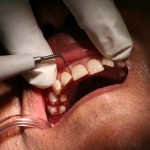
Periodontitis is common although a lack of consensus regarding its precise definition, severity and classification means that estimates of population prevalence are wide.Periodontal treatment is usually involved initial management of active disease involving assisting patients to perform effective oral hygiene, and mechanical debridement pf supragingival and subgingival microbial deposits with possible use of adjuncts. This is normally followed by a period of close monitoring through a formal programme of supportive periodontal therapy (SPT). This provides an opportunity for clinicians to promote periodontal health and detect and intercept recurrence or progression of periodontal disease. SPT could include debridement of any persistent periodontal pockets to disrupt microbial populations and minimise the inflammatory response that underpins disease progression.
The aim of this review was to determine the effects of supportive periodontal therapy (SPT) in the maintenance of the dentition of adults treated for periodontitis.
Methods
Searches were conducted in the Cochrane Oral Health’s Trials Register, the Cochrane Central Register of Controlled Trials (CENTRAL), Medline, Embase, The US National Institutes of Health Trials Registry (ClinicalTrials.gov) and the World Health Organization International Clinical Trials Registry with no restriction on date on language.
Randomised controlled trials (RCTs) with a minimum follow up period of 12 months that evaluated SPT versus monitoring only or alternative approaches to mechanical debridement; SPT alone versus SPT with adjunctive interventions; different approaches to or providers of SPT; and different time intervals for SPT delivery were considered. Split mouth studies were excluded. In addition, patients had to have completed active periodontal therapy at least six months prior to randomisation and be enrolled in an SPT programme. Primary outcomes included, tooth loss, bleeding on probing (BoP), clinical attachment level (CAL) and adverse events. Standard Cochrane data abstraction and analysis approaches were followed.
Results
- 4 RCTs involving a total of 307 patients were included.
- 1 study was considered to be at low risk of bias, 1 at high risk and 2 of unclear risk.
- 3 studies compared adjuncts (antibiotics [2 studies] and photodynamic therapy [1 study]) to mechanical debridement in SPT versus debridement only.
- No studies evaluated the effects of SPT versus monitoring only, or of providing SPT at different time intervals, or that compared the effects of mechanical debridement using different approaches or technologies.
- No studies evaluated tooth loss.
- There was no evidence of a difference between SPT delivered by a specialist versus a general practitioner for BoP or PPD at 12 months (very low-quality evidence). This study did not measure CAL or adverse events.
- Due to heterogeneous outcome reporting, it was not possible to combine data from the two studies comparing mechanical debridement with or without the use of adjunctive local antibiotics. Both studies found no evidence of a difference between groups at 12 months (low to very low-quality evidence). There were no adverse events in either study.
- The use of adjunctive photodynamic therapy did not demonstrate evidence of benefit compared to mechanical debridement only (very low-quality evidence). Adverse events were not measured.
- The quality of the evidence is low to very low for these comparisons. Future research is likely to change the findings; therefore, the results should be interpreted with caution.
Conclusions
The authors concluded: –
Overall, there is insufficient evidence to determine the superiority of different protocols or adjunctive strategies to improve tooth maintenance during SPT. No trials evaluated SPT versus monitoring only. The evidence available for the comparisons evaluated is of low to very low quality, and hampered by dissimilarities in outcome reporting. More trials using uniform definitions and outcomes are required to address the objectives of this review.
Comments
This Cochrane review had a number of specific objectives to compare: –
- SPT performed by periodontal specialists versus non- specialist dental professionals;
- SPT versus monitoring only, or alternative interventions that do not include mechanical debridement;
- SPT with and without adjunctive interventions delivered by dental professionals or self-administered;
- SPT performed using different techniques and appliances for mechanical root debridement;
- SPT provided at different time intervals.
Unfortunately, only a small number of studies met the inclusion criteria so several of these objectives could be met. While periodontal disease is very common many of the trials that have been conducted are shorter than the 12 months minimum which was, quite rightly, a key inclusion criteria for this review which was seeking to look at long term outcomes. The limited number of small studies that are available providing longer terms outcomes provide insufficient evidence for different treatment protocols and adjunctive strategies so more high-quality research is needed.
Links
Primary Paper
Manresa C, Sanz-Miralles EC, Twigg J, Bravo M. Supportive periodontal therapy (SPT) for maintaining the dentition in adults treated for periodontitis. Cochrane Database of Systematic Reviews 2018, Issue 1. Art. No.: CD009376. DOI: 10.1002/14651858.CD009376.pub2.
Other references
Dental Elf – 11th Aug 2017
Periodontal maintenance after specialist treatment: specialist or primary care setting?
Dental Elf – 9th Aug 2017
Dental Elf – 6th Feb 2017
Periodontal treatment: outcomes from long-term conservative management
Dental Elf – 7th Mar 2016
Amoxicillin and metronidazole as an adjunct to scaling and root planning for periodontitis?
